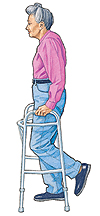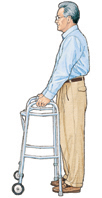Discharge Instructions: Using a Walker
Discharge Instructions: Using a Walker
Your healthcare provider as prescribed a walker for you. To use your walker, you need to learn a new gait, or way to walk. Your healthcare provider will tell you to use either a non-weight-bearing gait (putting no weight on one leg and foot) or a weight-bearing gait (putting weight on both legs and feet).
Guidelines for use
Tips for use include the following:
Remove throw rugs, electrical cords, and anything else that may cause you to fall.
Arrange your household to keep the items you need handy. Keep everything else out of the way.
Use a backpack, fanny pack, apron, or pockets to carry things so you keep your hands free.
Non-weight-bearing method
Steps for this method include:
Hold your injured (weaker) foot off the floor.
Lift the walker (roll it if you’re using a wheeled walker).
Move the walker forward about 12 inches.
Support your weight on your hands.
Swing your good (stronger) foot forward to the center of the walker.
Weight-bearing method
Steps for this method include:
Roll the walker (lift it if you’re using a walker without wheels).
Move the walker forward about 12 inches.
Step forward with your injured leg, new joint, or weaker side first.
Use the walker to help you keep your balance as you take the step.
Bring your other foot forward to the center of the walker.
Updated:
October 10, 2017
Sources:
Overview of Geriatric Rehabilitation: Program Components and Settings for Rehabilitation. UpToDate
Reviewed By:
Joseph, Thomas N., MD,Moloney Johns, Amanda, PA-C, MPAS, BBA





